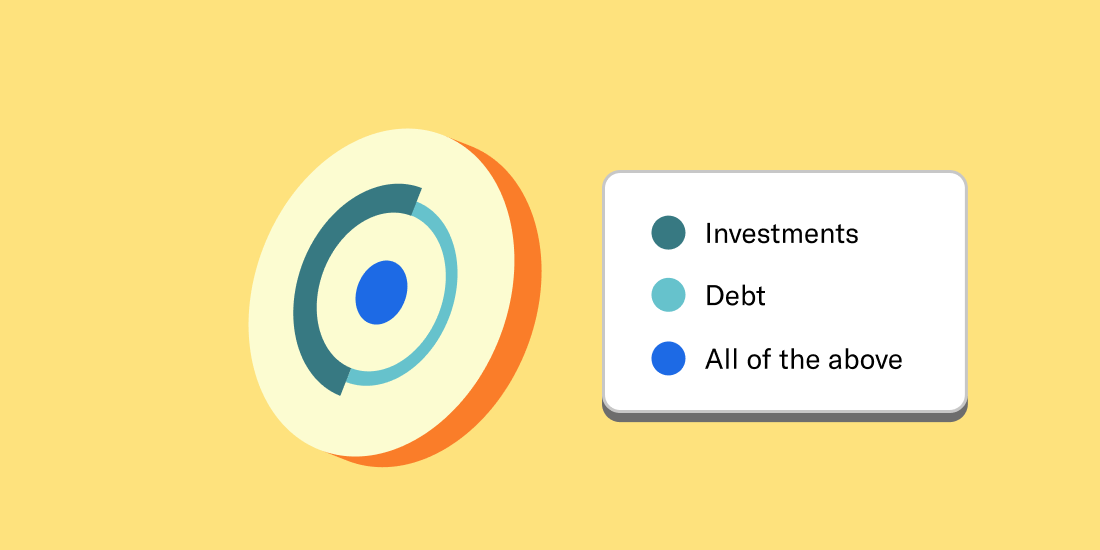How to manage debt and invest at the same time
With the right strategy, it's possible to make progress on both goals.

Managing debt and investing is a tricky balancing act. You can’t do everything at once, but paying off debt and building wealth are both vital to your financial future.
In this guide, we’ll explain how to manage debt and invest in six steps:
- Account for your spending
- Make minimum debt payments
- Contribute to an employer-matched retirement plan (if you can)
- Focus on high-interest debt
- Build an Emergency Fund
- Invest for the long-term
First, let’s talk about your debt, your goals, and your repayment strategy.
Planning around your debt
Debt can completely derail your financial goals. It eats through your savings and can offset the gains you make through investing. Repaying major debt like student loans can feel like climbing a mountain.
But not all debt is the same. High-interest credit card debt will quickly outpace your investment earnings. Ignore it, and it will consume your finances.
Debt with lower interest rates, like some student loans or your mortgage, can be much less of a priority. If you put off investing in favor of attacking this debt, you may not have time to reach your goals.
It is possible to pay debt and invest at the same time—the key is to create a strategy based on your debt and your financial goals.
At Betterment, we recommend focusing on the debt with the highest interest first. The more time you give this debt to grow, the harder it becomes to pay off.
Now let's walk through Betterment’s six steps to manage your debt and invest.
Step 1: Account for your spending
Your finances are finite. You have a limited amount of money to pay down debt, invest, and cover your expenses. The first step is to learn what comes in and goes out each month.
How much do you have to work with after rent, food, utilities, and other fixed expenses? Are there expensive habits you can eliminate to free up more money? Don’t plan to make changes you can’t stick to. The goal here is to establish a monthly budget, so you have enough to cover your bills and know how much you can save or put towards debt. We also recommend keeping enough in your checking account to act as a small buffer—three to five weeks of living expenses is generally a good rule of thumb—as even the best laid plans (or budgets) are derailed at times.
Step 2: Make minimum payments
You really don’t want to miss your minimum payments. Fees and penalties make your debt hit harder, and they’re usually avoidable. Think of your minimum debt payments as fixed expenses. After your regular living expenses, minimum debt payments should be a top priority.
Step 3: Contribute to an employer-matched retirement plan
If your employer offers to match contributions to a 401(k), that’s free money! Don’t leave it on the table. A 401(k) also comes with valuable tax benefits. Even if it under performs, the match program allows your contributions to grow faster. It’s like your employer is giving your financial goals a boost. And that’s why this is almost always one of the smartest investment moves you can make.
Step 4: Focus on high-interest debt
When it comes down to it, high-interest debt is your biggest enemy. It’s a festering financial wound that grows faster than any interest you’re likely to earn. Left unchecked, credit card debt can easily cost you thousands of dollars in interest or more. And that’s money you could’ve invested, applied to other debt, or saved.
Step 5: Build an Emergency Fund
Without an emergency fund, you’re one unexpected medical bill, car accident, or surprise expense away from even more debt. Generally we encourage you to pay off your high interest debt before fully funding a three to six month emergency fund. However, some people, particularly those who are worried about income loss, prefer building a large cushion of cash for emergencies first over paying down extra debt
Step 6: Invest for the long-term
Once you’ve paid down your high-interest debt, you can begin investing for the long-term. With a diversified portfolio, your investments can outpace your lower-interest debt. So you can work toward financial goals while making minimum payments.
Using automatic deposits, you can create an investment plan and stick to it over time, treating your investments as part of your fixed budget. Your emergency fund will give you some financial breathing room, and before you know it, you’ll be making progress toward retirement, a downpayment on a house, college for your kids, or whatever your goal is.
Start working toward your goals
Paying off debt and investing in your future isn’t an either/or situation. With the right strategy, you may be able to do both. If you want to take responsible steps toward managing your debt and reaching financial goals, Betterment can help. You can start by syncing your financial accounts to see all of your finances in one place, then set up an Emergency Fund.
